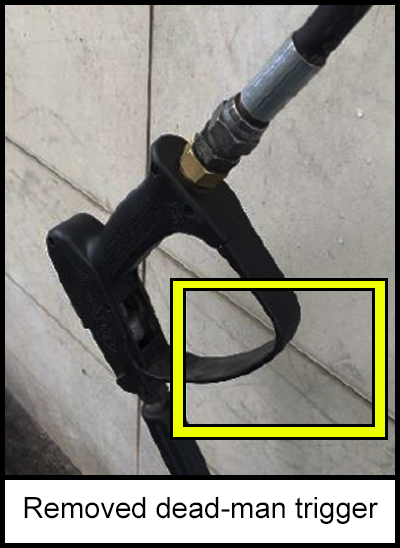-
What happened?
At a gas station a worker was cleaning a car with a high-pressure washing lance (200 bars).
The worker tripped over a soap hose that was on the ground.
He lost control of the pressure washer, which spun uncontrollably.
The lance did not have a trigger or dead-man switch.
High pressure water hit the worker’s nose and eye, causing serious eye injuries.

-
Why did it happen?
The dead-man trigger was removed from the washing lance because the water pump kept breaking down frequently (due to overpressure).
Without a dead-man trigger, high pressure water continued to flow.
Eye protection was not mandatory on site.
Poor routing of hoses on the ground caused the worker to trip.
There was no official specification/manufacturer manual for the high-pressure washing lance.
No risk assessment was done when the water pressurisation system was installed.

-
What did they learn?
Wear eye protection when operating high-pressure jet equipment.
Make the installation of triggers and dead-man switches mandatory.
Monitor and adjust pump pressure levels to prevent high values.
Review existing training material and re-train the workers in this activity if necessary.
Review and improve water pressurisation systems when necessary.
Complete risks assessments changes in technical systems are made.

-
Ask yourself or your crew
What other actions could have been taken?
How could something similar happen to us?
Have our lances (or other equipment) been modified like this?
How do we know these modifications are safe?
What changes should we make (on site, equipment or how we work) to prevent injuries during high pressure washing?

Add to homescreen
Content name
Select existing category:
Content name
New collection
Edit collection
What happened?
At a gas station a worker was cleaning a car with a high-pressure washing lance (200 bars).
The worker tripped over a soap hose that was on the ground.
He lost control of the pressure washer, which spun uncontrollably.
The lance did not have a trigger or dead-man switch.
High pressure water hit the worker’s nose and eye, causing serious eye injuries.

Why did it happen?
The dead-man trigger was removed from the washing lance because the water pump kept breaking down frequently (due to overpressure).
Without a dead-man trigger, high pressure water continued to flow.
Eye protection was not mandatory on site.
Poor routing of hoses on the ground caused the worker to trip.
There was no official specification/manufacturer manual for the high-pressure washing lance.
No risk assessment was done when the water pressurisation system was installed.
What did they learn?
Wear eye protection when operating high-pressure jet equipment.
Make the installation of triggers and dead-man switches mandatory.
Monitor and adjust pump pressure levels to prevent high values.
Review existing training material and re-train the workers in this activity if necessary.
Review and improve water pressurisation systems when necessary.
Complete risks assessments changes in technical systems are made.
Ask yourself or your crew
What other actions could have been taken?
How could something similar happen to us?
Have our lances (or other equipment) been modified like this?
How do we know these modifications are safe?
What changes should we make (on site, equipment or how we work) to prevent injuries during high pressure washing?
At a gas station a worker was cleaning a car with a high-pressure washing lance (200 bars). High pressure water hit the worker’s nose and eye, causing serious eye injuries.













